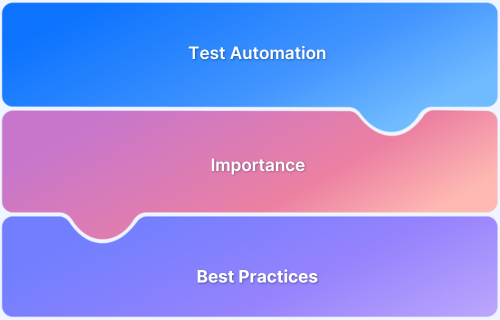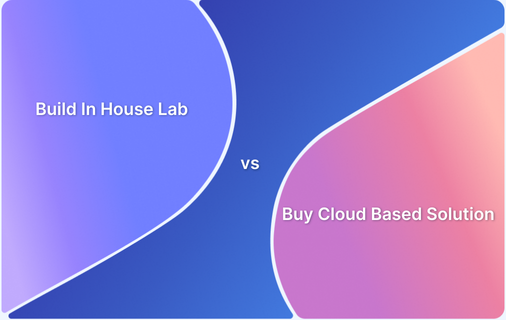How does Model-Based Testing improve Test Automation?
By Amrita Vazirani, Community Contributor - February 11, 2025
With the rise of Agile and DevOps methodologies, the software development life cycle (SDLC) has become shorter and more iterative. As a result, the need for comprehensive and reliable test automation has never been greater.
Model-Based Testing (MBT) streamlines test automation by generating test cases from predefined models, ensuring efficiency and accuracy.
This article delves into how Model-Based Testing enhances test automation, enabling faster feedback, streamlined workflows, and cost-effective testing while maintaining the high standards required for continuous delivery.
- What is Model-Based Testing?
- Benefits of Model-Based Testing
- How does Model-Based Testing work?
- Popular Model-Based Testing Tools in the Market
- Different Approaches to Create Model-Based Tests
- How does Model-Based Testing improve Test Automation?
- Limitations of Model Based Testing
- Best Practices for Effective Model Based Testing
What is Model-Based Testing?
Model-based testing is a type of software testing method that uses a system’s model under test to generate test cases. Test automation tools that use this approach can create tests automatically from the model or semi-automatically with some user input.
Model-based testing (MBT) can be combined with popular testing tools and automation frameworks, thereby assisting your QA team to create both manual and automated scripts and increase test coverage.
Learn More: How To Ensure Maximum Test Coverage?
This approach can be used for any software testing but is particularly well suited for testing complex systems with many possible states or behaviors. Model based test automation can help reduce the time and effort required to create and maintain manual test cases and can also help improve the coverage and accuracy of tests.
Benefits of Model-Based Testing
Model-Based Testing provides a structured approach to automating test case generation and execution, enabling faster and more effective testing.
Here’s how Model Based Testing adds value to the software development lifecycle:
- Early Defect Detection: Model Based Testing enables the identification of issues during the requirements or design phase by validating models early. This prevents defects from progressing into development, reducing costly fixes later.
- Reduced Maintenance Effort: Since test cases are directly generated from models, any updates to the system or models automatically update the test cases. This minimizes maintenance costs, especially in large and complex systems.
- Reusable Test Assets: Models and test cases created during development can be reused for regression testing, ensuring consistency and optimizing the return on investment in testing efforts.
- Alignment with Agile and DevOps: Model Based Testing integrates seamlessly with Agile and DevOps practices by supporting continuous testing and rapid feedback loops. Automatically generated test cases can be included in CI/CD pipelines, ensuring quality and faster delivery.
- Improved Test Coverage: By generating test cases based on models that outline all potential system behaviors and scenarios, Model Based Testing ensures comprehensive test coverage, helping identify defects earlier in the development process.
How does Model-Based Testing work?
Model-based test is a methodology that uses a model of the system under test to generate test cases. The model can be either static or dynamic. Static models are typically used for GUI testing, while dynamic models are used for API testing.
To generate Model test cases, the tester does the following:
- Creates a representation of the system under test using a graphical tool, such as a UML diagram, or by writing code.
- Once the model is created, define each test case’s input and expected output values.
- Executes the test case and compares the actual output to the expected outcome. If there is a discrepancy, then the tester reports a failure.
Must-Read: Test Automation Tool Evaluation Checklist
Popular Model-Based Testing Tools in the Market
There are different model-based testing tools available in the market. Each of these tools has its advantages and disadvantages which is why it’s crucial to choose a suitable one. Some of the most popular Model-based testing tools are:
- IBM Rational Test Workbench: IBM Rational Test Workbench is a model-based test automation tool that uses a model to represent the application under test and then generates test cases based on that model.
- Parasoft SOAtest: Parasoft SOAtest is a model-based test automation tool that can test web services. It uses a contract-first testing approach, starting with the WSDL file. From there, it generates test cases based on the WSDL file. The advantage of this approach is that it can catch errors early on in the development process.
- Microsoft Visual Studio: Microsoft Visual Studio Team System 2008 Testing Edition is a software testing tool that automates the testing process. It is based on the Model-Based Testing approach, which uses a system’s model under test to generate test cases.
Must Read: Model Based Testing Tools
No matter, which testing tool you go by, always remember that you’re testing for users who will be using it on real devices under real user conditions such as low battery status, constant push notifications, dark mode, and older browser versions. With BrowserStack Real Device Cloud you can access your on-demand cloud of 3000+ device/browser combinations for real device testing.
Start Automation Testing for Free
Different Approaches to Create Model-Based Tests
Model-Based Testing employs various modeling approaches to represent system behavior and facilitate automated test generation.
Below are some common approaches used in Model Based Testing:
- Statecharts: An advanced form of finite state machines (FSMs) that supports complex transitions, parallelism, and hierarchical states. Often used to model reactive systems like embedded devices and user interfaces.
- Markov Models: Represent probabilistic system behavior where state transitions are governed by probabilities. Widely applied in performance analysis, reliability testing, and stochastic process modeling.
- Decision Tables: Tabular representations of complex decision logic, useful for modeling systems with conditional behavior. Frequently used in validating business rules and rule-based systems.
- Entity-Relationship Diagrams (ERDs): Visualize relationships between entities in database schemas. Used in database design to model data structures and dependencies.
- Control Flow Graphs (CFGs): Illustrate the execution flow of a program, showing control sequences. Applied in test case generation, coverage analysis, and behavioral analysis of programs.
- Data Flow Diagrams (DFDs): Depict how data moves through a system, highlighting inputs, processing, and outputs. Useful for identifying data dependencies and validating data transformations in software.
- Unified Modeling Language (UML) Diagrams: Provide standardized notations for representing software components. Use case diagrams model user interactions, while activity diagrams map the flow of control within a system.
- Test Modeling Language (TML): A text-based modeling language that enables the creation of detailed and complex models. While powerful, it can be less user-friendly compared to graphical modeling tools, making it ideal for more advanced or highly customized scenarios.
How does Model-Based Testing improve Test Automation?
Automation testing is the process of automating the execution of test cases. This can be done either manually or using a tool. However, model-based test automation is a more efficient and practical approach.
Model-based test automation involves creating a model of the system under test. This model can be used to generate test cases automatically. This approach has many benefits over traditional automation approaches.
- Highly efficient since it does not require the manual creation of test cases.
- More effective since the generated test cases will likely be more comprehensive and accurate.
- Can be used to create both positive and negative test cases.
- Generate both functional and non-functional test cases.
This approach can create both unit and integration test cases.
With BrowserStack Automate, testers can seamlessly integrate model-based testing with 3500+ real browsers and devices.
It supports parallel testing for faster execution, delivering accurate results under real-world conditions. This ensures efficient testing processes, quicker releases, and enhanced software quality.
Advantages of Model Based Testing
The advantages of using a model-based test approach are as follows:
- Automation Efficiency: Streamlines the testing process with higher levels of automation and precision.
- Comprehensive Testing: Ensures thorough validation of system updates or changes.
- Versatility: Leverages models like finite state machines, UML diagrams, and state charts for accurate system representation.
- Cost and Time Savings: Reduces costs by automating repetitive tasks and enables simultaneous execution of multiple tests.
- Early Defect Detection: Identifies and addresses issues early in development, reducing risks.
- Low Maintenance: Test cases are directly derived from models, simplifying updates during system changes.
- Reusability: Test assets can be reused for regression testing and across projects.
- Agile-Friendly: Supports rapid feedback cycles, aligning well with Agile and DevOps practices.
Limitations of Model Based Testing
Here are some common limitations of Model Based Testing:
- Requires Formal Specifications: Accurate models depend on detailed specifications; incomplete or unclear specifications can lead to ineffective tests.
- Steep Learning Curve: Creating and utilizing models can be complex, requiring significant training and expertise.
- High Initial Investment: Building and maintaining models demands time, effort, and resources, leading to higher upfront costs.
- Model Accuracy Dependency: Test effectiveness relies on the model’s accuracy; poor models result in unreliable tests.
- Continuous Maintenance: Models need regular updates to stay aligned with system changes, increasing ongoing maintenance efforts.
Follow-Up Read: How BDD & Agile Together Make Testing Efficient
Best Practices for Effective Model Based Testing
Here are some best practices for effective model based testing:
- Define Clear Specifications: Ensure models are based on accurate and detailed system requirements.
- Regularly Update Models: Keep models updated to reflect changes in the system for ongoing relevance.
- Leverage Automation: Use automation tools to generate and execute tests efficiently.
- Prioritize Critical Scenarios: Focus on modeling key workflows and edge cases for better coverage.
- Collaborate Across Teams: Involve developers and testers to ensure the model accurately reflects the system.
Conclusion
Model-based test automation is a powerful strategy that can help reduce the amount of time and effort you spend on testing. Using models to generate test cases, you can dramatically increase your test coverage while reducing the number of manual tests you need to create.
In addition, model-based test automation can help you find more bugs earlier in the development process, saving you even more, time and effort in the long run. Model-based test automation is worth considering if you’re looking for a way to improve your testing efficiency.




